Posts Tagged ‘Chironomids’
{{start}}
When fly fishers refer to Chironimids they are generally referring to the grub or pupa stage of their life cycle. The term buzzer also refers to Chironomids but seems best suited to describing the insect when it has started to show its siphons. Toward the end of the life cycle Chironomids emerge and take to the wing in swarms of tiny non biting mosquito like insects often referred to as midge. Chironimids are found in both still and running water but I generally carry them in my lake fly box because that is where I am most inclined to use them.
WIP:
Epoxy marabou blood worm.
{{end}}
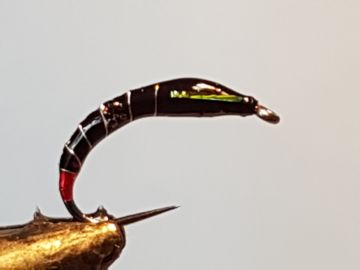
{{+1}}Epoxy midge – black with hot butt & UV cheeks{{-1}}
{{start}}
When Chironomids are around they tend to be around in large numbers and trout become quickly switched on and gorge on them. There are number of techniques to target chironomid feeders and one of my favourite is to fish three chironomid imitations with the heaviest on the point with a long leader on a floating line and fish relatively static. You will be surprised how many fish find your flies.{{end}}
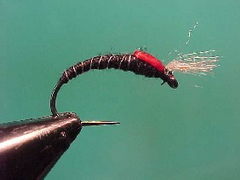
{{+1}}Chatto’s black alpine buzzer{{-1}}
{{start}}
This is the second in the series of three versions of the same fly. This first in the series is the bloodworm version. which is the original colour of the pupa as it emerges from the slime on the lake bottom. Over a short period of time the bloodworm changes to a dark colour with varying amounts of red present as the transformation occurs. As it reaches the surface the dark colour mellows and the pupa assumes a grey or olive colour similar to its terrestrial colour.{{end}}
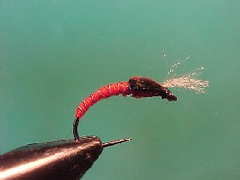
{{+1}}Chatto’s bloodworm alpine buzzer{{-1}}
{{start}}
This is the first in the series of three versions of the same fly and is representative of the original bloodworm colour of the pupa as it emerges from the slime on the lake bottom. The second fly in the series is black with flashes of red representing the pupa as changes to a dark colour with varying amounts of red present as the transformation occurs. The third fly in the series is representative of the colour of the pupa as it reaches the surface the dark colour mellows and the pupa assumes a grey or olive colour similar to its terrestrial colour.{{end}}

{{+1}}Muskins PTN{{-1}}
{{start}}
This is very popular Northern hemisphere fly and whist it more popular in still water it also has its uses in running water. Appealing to fish that are on mixed diet that includes mayfly nymph and midge.{{end}}
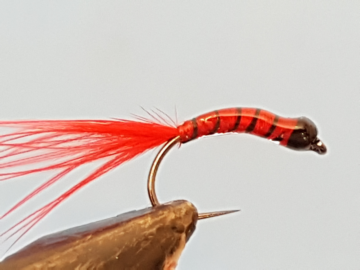
{{+1}}Bloodworm – Chatto’s TBH marabou bloodworm{{-1}}
{{start}}
A streamlined fast sinking fly that will anchor your team ... the UV mirage tinsel is just a fine line along the spine but is enough to ensure that the fly is seen at darker depths.{{end}}
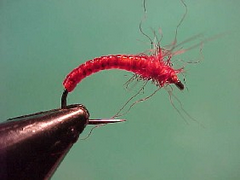
{{+1}}Jelly worm{{-1}}
{{start}}
This fly is a good represent of chironomids in their "blood worm" stage and it works well as an anchor fly in a team of two or three chironomids particularly when fished static early in the hatch.{{end}}
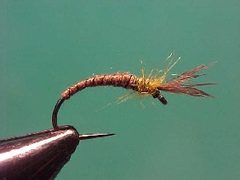
{{+1}}Chironomid{{-1}}
{{start}}
hilst trout do search out lava amongst the detritus matter and eat lava that have been disturbed by wind and wave action it is generally the free swimming pupae that are most often eaten by trout. Whilst the lava is generally found in the lower reaches the pupa can be found in a wide range of depths from very shallow to up to 10 meters.{{end}}
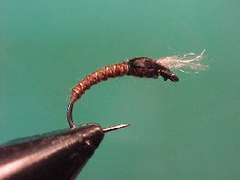
{{+1}}Chatto’s emerging alpine buzzer{{-1}}
{{start}}
When browns and rainbows are feeding on hatching midges at the exclusion of all else this buzzer chironomid pattern and when a little lead is added for weight in the tie I find is a good choice for point fly in a team of three flies.{{end}}
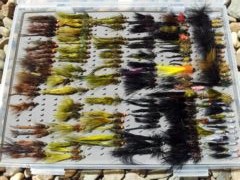
{{+1}}My “trout” fly boxes{{-1}}
{{start}}
The number of fly boxes you carry is obviously one of personal choice. One difficulty you may encounter when you are setting up your fly boxes is which flies you should include, and how many flies you should carry in your fly box or boxes. The last thing you want to be doing is standing on the bank of a river madly pulling flies out to find a fly you know is there . . .somewhere, but it isn't where you expected to find it or you fly box or boxes are so crowded with flies that the one you are desperately looking for is hidden away . . . somewhere.{{end}}













